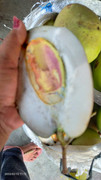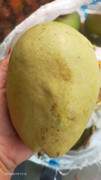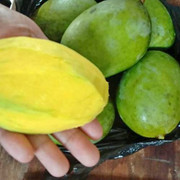Wanyi (Mangifera Caesia)Wanyi (Mangifera Caesia) is a fruit with a sweet taste and fragrant smell when it is ripe. The flesh is white and the skin is green, with a shape almost like a mango. Wanyi can be found in the Tenggarong area, Kutai Kartanegara, East Kalimantan.
The tree has rough, brown bark, sharp leaves, oval fruit shape, the texture of the flesh is like mango, the flesh is milky white. Although the fruit is like mango, but the aroma is much more pungent. Uniquely this fruit skin remains green even though the fruit is ripe. In the past, the fruit was harvested every two years, now it can be once every four years. Wanyi fruit sap needs to be watched out for, because if you come into contact with the sap you can experience itching.
Wanyi fruit is a fruit that is still in the same family as mangoes. This fruit is produced from a large and tall tree. Even the height can reach 12 meters with a sharp-shaped leaves.
The fruit itself is oval in shape, with a green to brown skin. If eaten, the texture of the milky flesh is very soft. Another feature of this fruit is that it has a very fragrant aroma, with a slightly sour sweet taste, and contains a lot of water.
Besides being known as the wanyi fruit, this fruit whose scientific name is Mangifera Caesia, also has other names, including Palong and Kemang.


10$/pcs
M Caesia Out Of Stock, SOLD OUTLimus, Bacang, pakel (Mangifera foetida Lour.)Limus, Bacang, pakel (Mangifera foetida Lour.) is a fruit tree that is related to mangoes. People often refer to the fruit as Bacang, Ambacang/Embacang, or Bacang Mango. In various places it is also known by various names such as limus, pakčl, tamarind, macang or machang (Malays in eastern Sumatra and Malaysia), maa chang, ma chae, or ma mut (Thailand), and la mot (Myanmar). In English it is called bachang or horse mango.
Large straight-trunk tree, can reach 30-35 m. The bark is brown to dark gray brown, broken with shallow furrows. When injured (all parts of the plant) secrete whitish gray lymph, which gradually becomes reddish and black. This sap is sharp, itchy and can injure the skin (especially mucous membranes). Does not have buttresses (root boards).
The leaves are rather stiff and leathery, with long stiff stems 1.5 – 8 cm. The leaves are more or less oblong in shape, 9-15 × 15–40 cm, glabrous and dark green.
Inflorescence in panicles slightly at the end, erect branching, like a pyramid, 10–40 cm long, dark red to copper red and smells good. Small dense flowers, numbered 5; petals 4–5 mm, obovate; crown 6–9 mm, narrow lanceolate, pink to pale yellow at tip.
Stone fruit oval or nearly round, 7-12 × 9-16 cm, thick-skinned and glabrous, green to yellowish, dull, with brownish lenticel spots. The flesh of the fruit when ripe is pale yellow-orange to yellow, fibrous, sweet-sour in taste and contains a lot of fruit juice, pungent smell a bit like turpentine.



9$/pcs
Asam Payang Or mambangan or bambangan has the Latin name mangifera pajangAsam Payang Or mambangan or bambangan has the Latin name mangifera pajang. Included in the family Anacardiaceae or included in the genus Mangoes.
In particular, this fruit is endemic to Borneo, which means it can only be found on the island of Borneo.
For its distribution, this plant grows wild throughout the forests of Kalimantan. It's just that because it is already rare, it is very difficult to find this fruit now.
Reportedly, currently bambangan fruit can only be found in the area of West Kalimantan.
The skin of the fruit is quite thick and gummy and if it gets in contact with the sap, the sap will irritate the skin and make it itchy, as well as the sap on wood and tree bark.
If in one garden there are Mangifera foetida and Mangifera pajang trees planted together, then cross-pollination will occur where the results of the cross-pollination have the characters of the 2 species.
Long mangifera are usually grown from seed
This bambangan fruit is also known as tamarind and tamarind. Not without reason, many people consume this fruit by processing it into tamarind and salad.
For the taste of this fruit there is a sour and sweet.
There is one unique way to open the skin of this fruit, namely by peeling it, following from the base of the stalk down.
If peeled upside down, the flesh will come off with the skin.
This bambangan fruit is also known to have many benefits that are good for the body.
Rich in vitamin C, beta carotene, and antioxidants, this fruit is believed to cure breast cancer and reduce the risk of heart disease.
Also good for digestion because it is rich in fiber.



7$/pcs
Kuini / Mangifera Odorata
Mangifera Odorata Of the many genera of mangoes, kuweni fruit is very easy to recognize. The smell is pungent. Kuweni fruit flesh is dense, soft, and the fiber is fine, although the fruit skin is rather thick.
This species is known by a variety of similar names in many areas. In Java, kuweni is also known as kweni or kaweni, while in Sunda it is known as kaweni, marry, bembem. The mention in Bali is almost the same, kweni or weni.
Other local names are kweni, tamarind, macang, lekup (Malay); kuwini, ambacang, embacang, practicing (Minangkabau); kuweni, kebembem (Betawi); kabeni, beni, bine, pao cabinet (Madura); pao kaeni (Sapudi Island); mango kuini (North Sulawesi); as well as kuini, guin, koini, kowini, koine, guawe stinki, sitingki, hitingki (various names in Maluku).
In the region of Sabah, Malaysia, this fruit is called huani or wani, almost the same as the name in the Philippines, namely huani, uani, or juani.
Same with mango, quoting from Wikipedia, kuweni is also popular as a garden plant. This tree is grown mainly for its fruit which people like because of its fragrance. Ripe kuweni fruit, eaten as table fruit or used as a mixed drink.
The quality of the fruit varies depending on the cultivar. The one that is considered the best is the one that smells less strong, tastes sweet, has less fibrous flesh, and has lots of fruit juice.
People also use the kernels of the seeds to be ground into flour, as an ingredient for making dodol-like foods. Kuweni bark is used as a traditional medicine. In addition, kuweni is also useful in industry and as an ingredient in certain medicines.
Kuweni, which has the scientific name Mangifera × odorata, Griffith, is a type of mango that is still closely related to the dumplings (Mangifera foetida, Lour). The difference is, kuweni fruit flesh is denser than dumplings. The fruit fiber is also finer. Dumplings are rounder and the skin is tougher and thicker, with many lenticel spots rather tightly spaced.
Some references say kuweni has never been found living in the wild. Because of that, experts believe this plant is the result of a natural cross between mango and rice dumplings. The research results of R Kiew, LL Teo, and YY Gan (2003) support this conclusion.
Kuweni mango trees grow well in the lowlands to an altitude of about 1,000 meters above sea level, different from other types of mangoes that have economic value. The area he likes is an area with rather high but evenly distributed rainfall throughout the year, so this plant is suitable to replace mangoes which generally grow better in dry areas. Kuweni is usually propagated by seeds.
Kuweni's fragrance, both fruit and flowers, was quoted from fruitipedia.com, which led to the naming of the species "odorata" (odor is the same as smell).
Kuweni or kuwini (Mangifera × odorata) is a fruit tree of the mango family which is still closely related to dumplings. This plant has fragrant fruit and soft pulp. The consistency of kuweni fruit flesh is denser than dumplings and the fiber is finer. Its character is between mango and rice dumplings, and experts also consider it a natural interspecific hybrid between mango and rice dumplings.
The shape of the kuweni is rounded and bigger than the mango. The tree, leaves, and fruit of the mango and kuweni are different. The shape of the kuweni tends to be larger than most mangoes.
Kuweni meat and mango meat are also different. When compared to mango flesh which is generally soft and smooth, the kuweni flesh is fibrous, the skin of the kuweni fruit is also thicker.
Mango has a distinctive fruity aroma. According to Sobir, the aroma of mangoes tends to disappear the longer the fruit is stored.
The aroma of kuweni is more pungent than mango. The longer it is stored, the distinctive mango aroma actually changes to a sweet smell which indicates that the mango is very ripe. If the mango aroma slowly disappears after being stored for a long time, kuweni actually has a distinctive and pungent fruity aroma.



Price : 7$
Kasturi mango (Mangifera casturi), Have you ever tasted musk fruit? If so, you could be one of the lucky ones, considering that this endemic fruit from the island of Borneo is very hard to find.
Kasturi fruit is also known as Kasturi mango (Mangifera casturi) or Kalimantan mango. Kasturi mango is an endemic plant typical of South Kalimantan whose existence is threatened with extinction. The taxon population tends to decrease, both in terms of the number of individuals, population and genetic diversity. The status of the scarcity of this fruit was analyzed using the categories and criteria of endangered plants according to the IUCN Red List Categories 30 November 1994.
An assessment team from the World Conservation Monitoring Center in 1998 determined Mangifera casturi to be in the extinct category in the wild. This mango is known to only live and grow naturally in forest gardens and or other conservation areas, but is no longer found in its natural habitat.
The shape of the tree is similar to the common mango (Mangifera indica), namely the plants can reach a height of 25-50 meters, a trunk diameter of 40-115 cm, and shady. When cut, the bark will release sap which is clear at first, then becomes reddish and black within a few hours.
However, unlike regular mangoes, Kasturi fruit has a small round or elliptical shape. The weight per fruit is only about 60-85 grams, 4.5-5.5 cm long, and 3.5-3.9 cm wide.
The fruit flesh is also stringy, the texture of the fruit is rather rough, the taste is sweet, slightly sour, and has a distinctive aroma. Another drawback of the Kasturi mango is that the flesh is not thick because the seeds are quite large.

